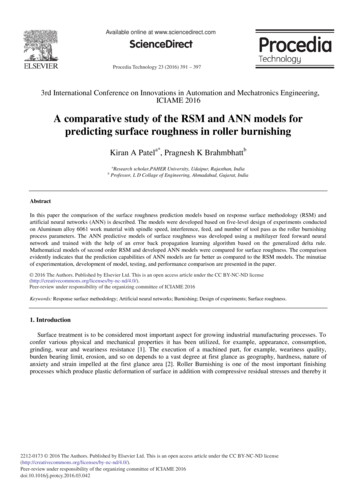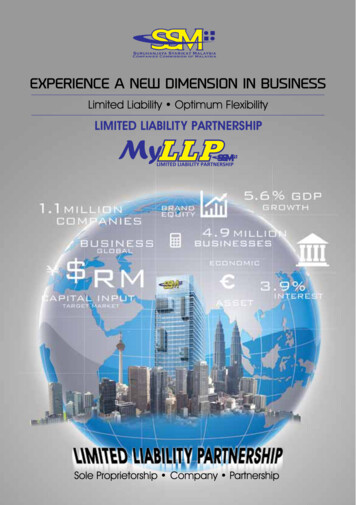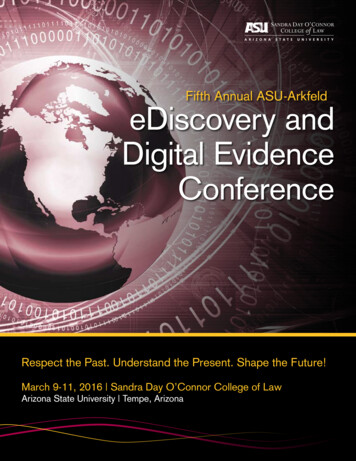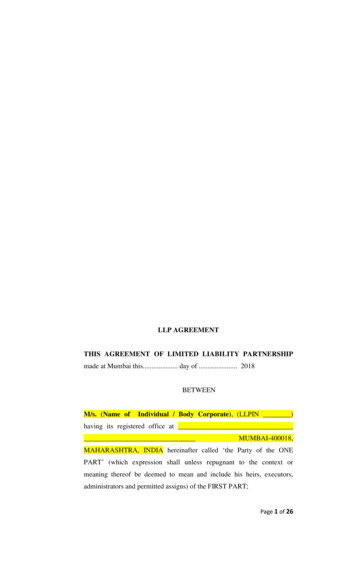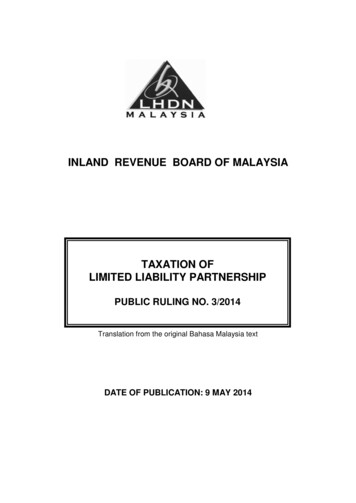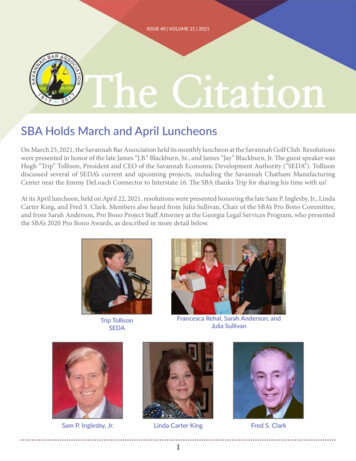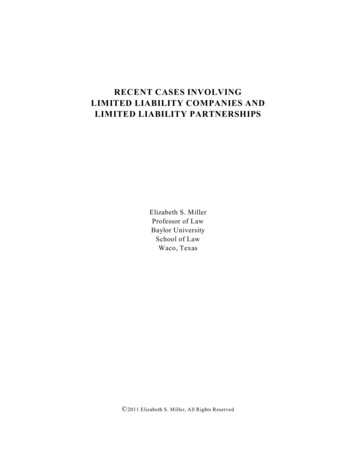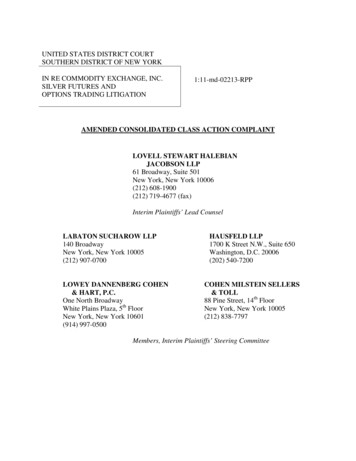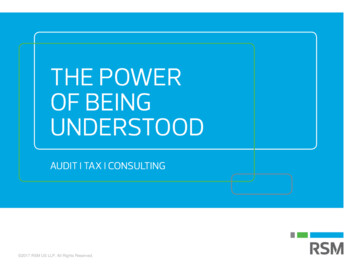
Transcription
2017 RSM US LLP. All Rights Reserved.
ACCOUNTING UPDATEPresented by Paul J. Nockels 2017 RSM US LLP. All Rights Reserved.
Broker-Dealer AccountingBroker-DealersPrivate Company Council 2017 RSM US LLP. All Rights Reserved.Exchanges3
Definition of a Public Business EntityA public business entity is a business entitymeeting the following criteria: It is required by the U.S. Securities and ExchangeCommission (SEC) to file or furnish financialstatements, or does file or furnish financialstatements (including voluntary filers), with theSEC (including other entities whose financialstatements or financial information are required tobe or are included in a filing). Broker-dealers are public business entities as theymeet the above definition Other entities meet the definition under separate criteria 2017 RSM US LLP. All Rights Reserved.4
Is a Futures Commission Merchant a PBE?Entities registered with the Commodity FuturesTrading Commission (CFTC) do not file with theSEC, unless they are dually registered Not public business entities under “criteria a” Could be a PBE under other criteria If not a PBE, delayed required adoption of newaccounting standards 2017 RSM US LLP. All Rights Reserved.5
Agenda Accounting Topics Accounting Standards Updates Other Topics 2017 RSM US LLP. All Rights Reserved.6
ACCOUNTING TOPICS 2017 RSM US LLP. All Rights Reserved.
Accounting Topics Revenue Recognition Leases Digital Currencies Restricted Cash Income Taxes (TCJA) Current Expected Credit Loss (CECL) 2017 RSM US LLP. All Rights Reserved.8
REVENUERECOGNITION 2017 RSM US LLP. All Rights Reserved.
Revenue Recognition Standard May 2014 – FASB and ISB issued substantiallyconverged final standards Eliminates industry specific revenuerecognition Comparability between industries Entity should recognize revenue to depict thetransfer of promised goods or services tocustomers in an amount that reflects theconsideration to which the entity expects to beentitled in exchange for those goods orservices. 2017 RSM US LLP. All Rights Reserved.10
Revenue Recognition Standard Entity should apply the following steps:1. Identify the contract(s) with a customer2. Identify the performance obligations in the contract3. Determine the transaction price4. Allocate the transaction price to the performanceobligation in the contract5. Recognize revenue when (or as) the entity satisfies aperformance obligation 2017 RSM US LLP. All Rights Reserved.11
Effective Date of ASU 2014-09, Revenue fromContracts with Customers (Topic 606)Effective DateAs issuedAs updatedPublic entitiesAnnual reporting periodsbeginning after December15, 2016, and the interimperiods within that yearAnnual reporting periodsbeginning after December15, 2017, and the interimperiods within that yearExample: Calendar year endQuarter and year beginningJanuary 1, 2017Quarter and year beginningJanuary 1, 2018Nonpublic entitiesAnnual reporting periodsbeginning after December15, 2017, and the interimperiods within annual periodsbeginning after December15, 2018Annual reporting periodsbeginning after December15, 2018, and the interimperiods within annual periodsbeginning after December15, 2019Example: Calendar year endYear ending December 31,2018 and interim periods in2019Year ending December 31,2019 and interim periods in2020 2017 RSM US LLP. All Rights Reserved.12
Early Adoption of ASU 2014-09, Revenue fromContracts with Customers (Topic 606)Early AdoptionAs issuedAs updatedPublic entitiesProhibitedPermitted in annual reportingperiods beginning afterDecember 15, 2016, and theinterim periods within that year(which was the original effectivedate for public entities)Nonpublic entitiesPermitted in any of the followingperiods: (a) an annual reportingperiod beginning after December 15,2016 or 2017, and the interim periodswithin that year or (b) an annualreporting period beginning afterDecember 15, 2016, and the interimperiods within annual periodsbeginning after December 15, 2017Permitted in any of the followingperiods: (a) an annual reportingperiod beginning after December15, 2016, and the interim periodswithin that year or (b) an annualreporting period beginning afterDecember 15, 2016 and theinterim periods beginning oneyear after that annual reportingperiod 2017 RSM US LLP. All Rights Reserved.13
Broker-Dealer Revenue StreamsRevenue StreamStatus of PaperCommission IncomeFinalized and included in the AIPCAGuide Revenue RecognitionCommission Income – Trade Date vsSettlement DateFinalized and included in the AIPCAGuide Revenue RecognitionSelling and Distribution Fee RevenueComment Period Closed – Final VersionOutstandingCosts associated with underwritingFinalized and included in the AICPA GuideRevenue RecognitionCosts associated with investment bankingadvisory servicesFinalized and included in the AICPA GuideRevenue RecognitionUnderwriting and related fee incomeFinalized to be included in a future editionof the AICPA Guide Revenue RecognitionAdvisory fee incomeFinalized to be included in a future editionof the AICPA Guide Revenue RecognitionSoft dollar revenuesFinalized to be included in a future editionof the AICPA Guide Revenue Recognition 2017 RSM US LLP. All Rights Reserved.14
Transition Alternatives Upon Adoption Retrospective application to all periods presentedwith the option to elect one or more practicalexpedients Modified retrospective No restatement of prior periods Apply ASU 2014-09 to in-progress contracts as of theadoption date going forward and subsequent contracts Recognize a cumulative effect adjustment at adoptiondate for effects of applying ASU 2014-09 to in-progresscontracts Disclose in the year of adoption the effect on each lineitem in the financial statements as a result of adoption 2017 RSM US LLP. All Rights Reserved.15
Required Disclosures Objective is to help financial statement usersunderstand the nature, amount, timing anduncertainty of the related revenue and cashflows Annual and interim disclosures required ofpublic entities Less on an interim basis, butmostly quantitative in nature More disclosures required of public businessentities and certain nonprofit entities andemployee benefit plans However, disclosuresfor all others are still significant 2017 RSM US LLP. All Rights Reserved.16
Required Disclosures Detailed quantitative and qualitative informationabout the following must be disclosed: Disaggregated revenue Contract assets, contract liabilities and receivable Performance obligations in general and the transactionprice allocated to the remaining performance obligationsat the end of the reporting period Significant judgments related to when performanceobligations are satisfied and used to estimate andallocate the transaction price Capitalized customercontract costs Capitalized customer contract costs 2017 RSM US LLP. All Rights Reserved.17
ASC Topic 606 disclosure requirements Entities that adopted ASC Topic 606 on a modified retrospectivebasis must disclose what accounting treatment would havebeen under legacy revenue guidance 2017 RSM US LLP. All Rights Reserved.
General tax revenue recognition rules (accrualmethod) Under an accrual method of accounting,income is includable when all the events tofix the right to receive the income and theamount can be determined withreasonable accuracy Revenue is fixed for tax when (1) the paymentis earned through performance, (2) payment isdue to the taxpayer, (3) payment is received bythe taxpayer, or (4) the item of gross income, orany portion thereof, is taken into account asrevenue in the AFS, whichever happens earliest 2017 RSM US LLP. All Rights Reserved.
Tax considerations of ASC 606 Direct impacts Federal current tax State current tax Indirect impacts Sales tax Excise taxes Transfer pricing 2017 RSM US LLP. All Rights Reserved.
ASC 606 – assessment of tax impactDefine scope Reflects company’s industry,complexity and internal resourcesFinancial reportingassessment Work collaboratively with financial reporting teamto identify potential tax issues and opportunitiesDetermine taxprocess Addresses level of analysis, specificaction steps, and implementation needsReview data andcalculateadjustments Involves determining proper taxmethods and calculating adjustmentsPreparedeliverables Provides summary of analysis andimplementation recommendations Implement 2017 RSM US LLP. All Rights Reserved.Includes assistance withforms and ASC 740 taxrelated items
What about SIPC Revenue? Definition of SIPC Revenue unchanged by ASC606 It is not clear how to address the cumulativeeffect adjustment at adoption date in the SIPC-6 Broker-dealers that are impacted could contact SIPCto clarify 2017 RSM US LLP. All Rights Reserved.
LEASES 2017 RSM US LLP. All Rights Reserved.
Leases Upon its effective date, FASB Update 2016-02,Leases, will require a lessee to recognize on itsbalance sheet assets and liabilities for all leasesother than those that meet the definition of shortterm leases. 2017 RSM US LLP. All Rights Reserved.
Treatment of Operating Leases under SECRule 15c3-1 In a letter to SIFMA dated November 8, 2016, thestaff of the Division of Trading and Markets statedit would not recommend enforcement action to theSEC under Exchange Act Rule 15c3-1 if a brokerdealer computing net capital adds back anoperating lease asset to the extent of theassociated operating lease liability. 2017 RSM US LLP. All Rights Reserved.
Treatment of Operating Leases under SECRule 15c3-1 Further, the Division will not recommendenforcement action to the SEC if a broker-dealerdetermining its minimum net capital requirementusing the AI standard does not include in itsaggregate indebtedness an operating leaseliability to the extent of the associated operatinglease asset. 2017 RSM US LLP. All Rights Reserved.
Treatment of Operating Leases pursuant toRule 1.17 under the Commodity Exchange Act SIFMA issued a no-action letter request to theCFTC dated February 8, 2018 Includes appendix of examples 2017 RSM US LLP. All Rights Reserved.
Leases Overview Scope Disclosures Effective date and transition 2017 RSM US LLP. All Rights Reserved.
Leases overview 2017 RSM US LLP. All Rights Reserved.
Related Party Leases No distinction between leases withrelated parties vs. third parties Application of Step 1 – determine ifcontract contains a lease Included in expense sharing agreements? Determination of contract terms, includinglength, renewal options, etc.? Form over substance if there is nocontract that is enforceable, is there nolease? NOW is a good time to revisit to clarifyarrangements 2017 RSM US LLP. All Rights Reserved.
Leases overview Changes for lessees Will record lease liability and right-of-use (ROU) asset formost leases Income statement expense presentation will depend onclassification of lease Changes for lessors Limited changes to lessor accounting model Classification criteria modified Leveraged lease accounting prospectively eliminated Changes for both Sale-leaseback criteria New presentation and disclosure requirements 2017 RSM US LLP. All Rights Reserved.
Scope Standard is applicable to all leases except: Leases of intangible assets Leases to explore for or use minerals, oil, natural gas,and similar nonregenerative resources Leases of biological assets Leases of inventory Leases of assets under construction Short-term leases election 2017 RSM US LLP. All Rights Reserved.
Lessee disclosuresExtensive qualitative and quantitative disclosuresTypeExample disclosuresQualitative Nature of leasesLeases that have not yet commencedVariable payment arrangementsTermination/purchase/renewal optionsQuantitative Amortization and interest for finance leasesOperating lease costVariable lease costShort-term lease costMaturity analysis of lease liabilitiesSignificantjudgmentsandassumptions Determining if a lease exists Standalone prices 2017 RSM US LLP. All Rights Reserved.
Lessor disclosuresExtensive qualitative and quantitative disclosuresTypeExample disclosuresQualitative Quantitative Lease income (in tabular format) Maturity analysis of undiscounted cash flows(segregated by finance/operating lease) 2017 RSM US LLP. All Rights Reserved.Nature of leasesVariable payment arrangementsTermination/purchase/renewal optionsInformation about management of residual asset risk
Effective dateNonpublic businessentities Annual and interim periodsPublic business entitiesin fiscal years beginningafter 12/15/2018 Early adoption permitted Modified retrospectivetransition Certain reliefs Fiscal years beginningafter 12/15/2019 Interim periods in fiscalyears beginning after12/15/2020 Early adoption permitted Modified retrospectivetransition Certain reliefs 2017 RSM US LLP. All Rights Reserved.
Transition Modified retrospective transition Full retrospective adoption is prohibited All comparative periods presented are restated “Packaged” transition reliefs Expired/existing contracts contain leases Lease classification for expired/existing leases Whether previously capitalized initial direct costs could still becapitalized Other transition relief Hindsight can be used in determining lease term andassessing impairment of ROU assets 2017 RSM US LLP. All Rights Reserved.
Leases: Targeted improvements to ASC 842 Entities will be given an additional option for transition, under whichthey will be allowed to elect to recognize a cumulative-effectadjustment to the opening balance of retained in the period of adoption,rather than in the earliest period presented. Reporting for comparative periods would remain under ASC 840Separating Components of a Contract Lessors would be allowed to apply a practical expedient to not separatenonlease components from the related lease components Lessors applying this expedient would account for the combinedcomponents as a single lease component, if both:1. The timing and pattern of revenue recognition for the nonleasecomponent(s) and related lease component are the same2. The combined single lease component would be classified as anoperating leaseProposed ASU 2017 RSM US LLP. All Rights Reserved.ProposedTransition—Comparative Reporting at Adoption
Adoption Readiness Review of contracts Updates to clarify related party lease arrangements Updates to policies and internal controls System updates Controls related to adoption Interactions with auditors Assess quantitative impact prior to January 1,2019 First reporting period – January ’19 FOCUSreport 2017 RSM US LLP. All Rights Reserved.38
New Lease Accounting Resource Center Information about adoption andimplementation of ASU 2016-02,Leases (Topic 842), including: Leases: Bring on the balance sheet Leases: New accounting requirements forlessees Leases: Overview of the new guidance SAB 74 disclosures for new standard onlease accounting A contact form for those who needhelp implementing the new standard Additional resources on leaseaccountingvisit - rsmus.com/asc842 2017 RSM US LLP. All Rights Reserved.
DIGITAL CURRENCIES 2017 RSM US LLP. All Rights Reserved.
Accounting and Financial Reporting of Digital Currencies Currently no authoritative literatureunder US GAAP that specificallyaddresses resulting in diversity inpractice What is it? Cash? Financial Instrument? Intangible?Inventory? Security? Commodity? Something New? Why is it? ICOs? Trading? Liquid Asset? Economicsconsideration? 2017 RSM US LLP. All Rights Reserved.
Accounting and Financial Reporting of Digital Currencies Recognition and measurement Trade/execution date?Time of day? Close of business?Offsetting considerationsCarrying value (fair value vs. cost, subject to impairment?) Disclosure considerations If fair value, fair value hierarchy? Operating risks (keys stolen, lost, destroyed or otherwisecompromised) Market risks Liquidity risks Counterparty and credit risks – cryptocurrencyplatforms/exchanges 2017 RSM US LLP. All Rights Reserved.
What about SIPC Revenue? It is not clear whether revenues earned by abroker-dealer related to digital asset activities isincluded in SIPC revenue Is the digital asset a security? Does it matter? 2017 RSM US LLP. All Rights Reserved.
RESTRICTED CASH 2017 RSM US LLP. All Rights Reserved.
Restricted Cash ASU 2016-18, Statement of Cash Flows (Topic230): Restricted Cash Effective for public business entities for fiscal yearsending after December 15, 2017 Designed to reduce diversity in practice in cashflow presentations Entities must include restricted cash and cashequivalents in the reconciliation from beginning toend-of-period total cash amounts Entities must disclose the nature of restrictions onrestricted cash 2017 RSM US LLP. All Rights Reserved.45
Broker-Dealer Considerations ASU does not include a definition – covers “ amounts generally described as restricted cashor restricted cash equivalents” Broker-dealers would consider properpresentation of disclosure of cash segregatedunder SEC 15c3-3/PAB requirements andCFTC regulations Several broker-dealers adopted for Q1 201810-Q 2017 RSM US LLP. All Rights Reserved.46
INCOME TAXES(TCJA) 2017 RSM US LLP. All Rights Reserved.
Financial statement impacts of Tax Cuts and JobsAct On December 22, the Tax Cuts and Jobs Act (the “Act”) wassigned into legislation Most significant change in U.S. tax law since 1986 Significant financial statement impacts on a number ofareas as a result of the Act including: Deferred tax assets and liabilities Accumulated Other Comprehensive Income (AOCI) Net operating losses (NOLs) Alternative minimum tax Foreign operations 2017 RSM US LLP. All Rights Reserved.
The Act New law changes the discussion on tax impacts ofrevenue recognition New tax revenue recognition rules for entities withapplicable financial statements (AFS) Significant changes Revenue is fixed for tax when (1) the payment is earned throughperformance, (2) payment is due to the taxpayer, (3) payment isreceived by the taxpayer, or (4) the item of gross income, or anyportion thereof, is taken into account as revenue in the AFS,whichever happens earliest Tax will also follow the allocation of the transaction price Does not apply to special methods of accounting (e.g.,percentage-of-completion, installment sales) 2017 RSM US LLP. All Rights Reserved.
Deferred tax assets and liabilities under the Act ASC 740 requires that the effects of a change in tax lawand rates be accounted for in the period of enactment Deferred tax assets and liabilities are required to be adjustedto reflect the effect of a change in tax rates in the period ofenactment The Act reduces corporate tax rates from 35% to 21% fortax years beginning after 12/31/17 In financial statements for interim or annual periods after12/22/17, deferred tax assets and liabilities should bedetermined based on the new corporate tax rate in effectwhen they will reverse Changes to deferred taxes would be recorded in continuingoperations and would not be subject to the intraperiodallocations 2017 RSM US LLP. All Rights Reserved.
Non-calendar year-end public business entities Non-calendar year-end public entities must reflect thechanges under the Act in the quarter that includes12/22/17 Estimated annual effective tax rate for the current yearshould be adjusted in the quarter of enactment Estimated change in the deferred tax items as of thebeginning of the year should be treated as a discreteitem in the quarter of enactment Scheduling of deferred tax items may be needed todetermine the appropriate tax rate for reversal 2017 RSM US LLP. All Rights Reserved.
ASU 2018-02, Reclassification of Certain Tax Effects fromAccumulated Other Comprehensive Income Changes in rates for items included in AOCI go throughincome taxes from continuing operations This results in a disproportionate tax effect beingrecorded in AOCI (referred to as stranded tax effects) Historically this disproportionate impact would havebeen reversed based upon an accounting policy election The ASU allows for reclassification from AOCI toretained earnings for stranded tax effects resulting fromthe Tax Cuts and Jobs Act 2017 RSM US LLP. All Rights Reserved.
ASU 2018-02, Reclassification of Certain Tax Effects fromAccumulated Other Comprehensive IncomeIf elected, the effective date for calendar year-endsPermittedRequired2019 2017 RSM US LLP. All Rights Reserved.
NOLs under the Act NOLs arising in taxable years beginning after 12/31/17may only offset 80% of current year taxable income NOLs arising in taxable years ending after 12/31/17may not be carried back but can be carried forwardindefinitely The Act does not change the pre-2018 NOL usage,carryover or carryback periods These changes will affect a company’s assessment ofthe ability to utilize NOLs against deferred tax liabilities 2017 RSM US LLP. All Rights Reserved.
Corporate alternative minimum tax under the Act Corporate alternative minimum tax is repealed fortaxable years beginning after 12/31/17 Existing AMT credits will continue to be allowed tooffset regular tax liability after other credits Any AMT credits not used to reduce regular tax willbegin to be refunded starting in years beginning after2017 These changes will result in a release of a valuationallowance against any AMT credits 2017 RSM US LLP. All Rights Reserved.
Foreign operations under the Act U.S. companies will be required to include in U.S. taxable incomethe total amount of unremitted foreign earnings of its controlledforeign subsidiaries Effective for a foreign corporation’s final year beginning prior to 2018,which would include years ending 12/31/17As a result, the concept of permanent reinvestment in a foreignsubsidiary would no longer be relevant as it relates to potential U.S.tax on foreign earnings Tax due on deemed repatriation may be paid over an eight-yearperiod An entity that elects to pay the tax related to repatriation over eightyears will need to record a portion of the payable as a current liabilityand a portion as a non-current liabilityAmount should not be recorded as a deferred tax item as it representsan actual tax liability 2017 RSM US LLP. All Rights Reserved.
SEC guidance In late December, the SEC issued SAB 118 (codified in SAB Topic5.EE) which addresses the application of ASC 740 in the reportingperiod that includes the date on which the Act was signed into law While ASC 740 provides accounting and disclosure guidance onaccounting for income taxes, it does not address the treatmentwhen the accounting for certain income tax effects of the Act isincomplete at the time financial statements are issued SAB 118 provides that in cases in which the accounting for certainincome tax effects of the Act is incomplete but companies canmake a reasonable estimate of the effects of the tax law change,that estimate should be recorded with appropriate disclosures The estimate would be reported as a provisional amount in the company’sfinancial statements during the one-year measurement period Any adjustments during the measurement period should be included inincome from continuing operations as a tax expense/benefit in thereporting period the adjustments are determined 2017 RSM US LLP. All Rights Reserved.
SEC guidance (cont.) If a company does not have the necessary informationavailable, prepared, or analyzed regarding certainincome tax effects of the Act to determine a reasonableestimate to be included as provisional amounts: No related amounts should be included in an entity’sfinancial statements for those specific income tax effects forwhich a reasonable estimate cannot be determined A company should continue to apply ASC Topic 740 (e.g.,when recognizing and measuring current and deferredtaxes) based on the provisions of the tax laws in effectimmediately prior to the Act being enacted 2017 RSM US LLP. All Rights Reserved.
January 10th FASB meeting FASB issued a Q&A indicating that Private companies could follow the SAB 118 guidance Deemed repatriation payments and refundable AMTcredits should not be discounted 2017 RSM US LLP. All Rights Reserved.
Challenges? Since enacted date of Act is tax yearsbeginning after 12/31/17, taxacceleration for ASC 605/various otherGAAP guidance in 2017 (privatecompanies) Then additional potential change in2018/2019 as ASC 606 is fullyimplemented across all required entities IRS has not yet commented on how toeffect any of these changes 2017 RSM US LLP. All Rights Reserved.
BBA Audit RulesIRS – amended partnership audit rules for tax yearsbeginning in 2018 TEFRA partnership audit rules replaced by the“BBA audit rules” (Bipartisan Budget Act of 2015) IRS will generally collect tax at partnership levelon adjustments at the highest corporate orindividual rate Accounting for uncertain tax positions will becomemore complex 2017 RSM US LLP. All Rights Reserved.61
Tax reform resource centerAdditional information on how legislation can affect your business andtax planningvisit - rsmus.com/taxreform 2017 RSM US LLP. All Rights Reserved.
CURRENT EXPECTEDCREDIT LOSS (CECL) 2017 RSM US LLP. All Rights Reserved.
CECL: Not Just for Banks Consideration of accounting for variousreceivables Brokerage Margin loans Securities lending Reverse repurchase agreements Related party arrangements? Additional disclosure requirements 2017 RSM US LLP. All Rights Reserved.
Overview of the credit losses standard ASU 2016-13, Measurement of Credit Losses onFinancial Instruments Creates ASC Topic 326 Subtopic 326-20 applies to financial assets measured atamortized cost Supersedes impairment guidance in ASC 310 onreceivables/loans and ASC 320 on debt securities(amongst other changes) 2017 RSM US LLP. All Rights Reserved.
Effective dates of the credit losses standard SEC filers – fiscal years beginning after 12/15/19 (including interimperiods) – 2020 for calendar year-end entities (“CYE”) Public Business Entities that are not SEC filers – fiscal yearsbeginning after 12/15/20 (including interim periods) – 2021 for CYE All others – fiscal periods beginning after 12/15/20 (interim periodsbeginning after 12/15/21) – 2021 for CYE Early adoption is permitted for fiscal years beginning after 12/15/18– 2019 for CYE Adopt through a cumulative effect adjustment to retained earnings Special rules for other-than-temporary impairment (“OTTI”), purchasedfinancial assets with a more-than-insignificant amount of credit deteriorationsince origination (“PCD assets”) and beneficial interests 2017 RSM US LLP. All Rights Reserved.
Applicability of ASC 326-20 The following are in-scope: Financial assets measured at amortized cost (AC)including: Financing receivables (loans) Held to maturity debt securities Receivables from revenue transactions with customers andother income Reinsurance receivables Receivables related to repo and securities lending agreements Net investment in leases Off-balance-sheet credit exposures Loan commitments Standby letters of credit Financial guarantees/similar instruments 2017 RSM US LLP. All Rights Reserved.
Applicability of ASC 326-20 The following are out of scope: Financial assets measured at fair value (FV) Available-for-sale securities Other Loans made to participants by defined contributionemployee benefit plans Policy loans receivable of an insurance entity Promises to give (pledges receivable) of a not-forprofit entity Loans and receivables between entities undercommon control 2017 RSM US LLP. All Rights Reserved.
Major provisions of ASC 326-20 Recognize expected (rather than incurred) creditlosses Through allowance for recognized financial assets(including held-to-maturity ("HTM”) debt securities) Through liability for off balance sheet exposures Results in day 1 life of asset expected loss recognition Exception: Initial allowance recorded as increase to purchaseprice for PCD assets (Assets that as of the date of acquisitionhave experienced a more-than-insignificant deterioration incredit quality since origination – “Purchased with creditdeterioration”) Changes in the allowance (plus and minus) are recordedimmediately through credit loss expense 2017 RSM US LLP. All Rights Reserved.
Major provisions of ASC 326-20 Measure expected losses on a pool basiswhenever similar risk characteristics exist No one method required. Some examples: Discounted cash flows Loss rate methods Roll-rate methods Probability of default methods Based on an aging analysis 2017 RSM US LLP. All Rights Reserved.
Major provisions of ASC 326-20 Consider relevant available information (internaland/or external) when estimating expectedlosses Don’t rely solely on past events – Adjusthistorical loss information for Differences in current asset specific riskcharacteristics Circumstances when historical info is not reflective ofcontractual term Current conditions Reasonable and supportable forecasts 2017 RSM US LLP. All Rights Reserved.
Major provisions of ASC 326-20 When estimating losses for periods beyondreasonable and supportable forecast, revert tohistorical loss information Input level or based on the entire estimate Immediately, straight line basis or another rationaland systematic basis Include measure of expected risk of loss even ifremote May reach conclusion expected credit loss is zero ifjustified based on historical loss info adjusted forcurrent conditions and reasonable and supportableforecasts 2017 RSM US LLP. All Rights Reserved.
Major provisions of ASC 326-20 Collateral dependent practical expedient (PE)available when: Borrower is experiencing financial difficulty Repayment is expected substantially through theoperation or sale of the collateral Base estimate of credit loss on a
Broker-Dealer Revenue Streams Revenue Stream Status of Paper Commission Income Finalized and included in the AIPCA Guide Revenue Recognition Commission Income -Trade Date vs Settlement Date Finalized and included in the AIPCA Guide Revenue Recognition Selling and Distribution Fee Revenue Comment Period Closed -Final Version Outstanding
